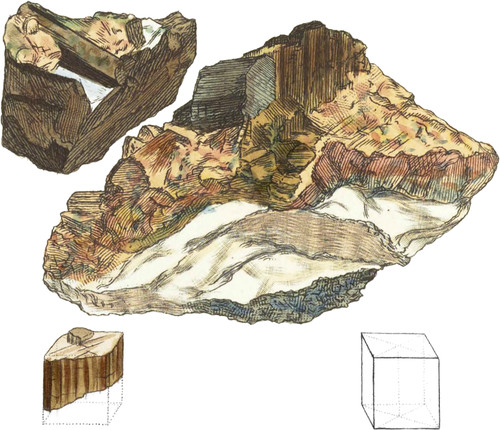 Enlarge
Enlarge
British Mineralogy
Idocrase, or Vesuvian Garnet
- Class 2. Earths.
- Order 1. Homogeneous.
- Gen. 4. Silex.
- Spec. Idocrasis.
- Syn.
- Hyacinthe var. 3 to 8. De Lisle, 2. 291.
- Vesuvian. Emmerl. 3. 314.
- Idocrase. Haüy, 2. 574.
It is found pretty abundantly in a rock chiefly composed of Mica, Hornblend and Garnet, on Mount Somma. The present specimen was found in the county of Donegal in Ireland, in what has commonly been called the Garnet Rock, which is usually gathered in fragments for the sake of the Garnet, for which this was sent to me; and is curious on account of its colour. The rock is composed of Phosphate of Lime, large-grained primitive gray Limestone, Quartz, in some parts coloured green by Phosphate of Lime*, and Garnet, among which is the Idocrase or Vesuvian of some authors, because it was first known as coming from that neighbourhood. This substance is recognised in the specimen, by its prismatic structure and rather darker colour, although lighter than usual: the Garnet is irregular, somewhat more salmon-coloured, and lighter; the Phosphate of Lime nearly white, and the gray at the bottom is the coarse-grained Limestone of the county, which is generally considered as primitive. The whole rock is certainly a curiosity, if considered in a geological point of view.
The small upper specimen has the Idocrase of the more usual darker and shining greenish brown, and the Garnet is crystallized; which assists in identifying it.
The crystal of the Idocrase is a rectangular four-sided prism, with the lateral planes streaked and the edges most commonly truncated. It is without its termination in my specimen; but Haüy exhibits a great variety of faces upon the short or obtuse pyramidal apex. It has a resino-vitreous appearance with very little transparency. It is hard enough to scratch glass. Its specific gravity is from 3.0882 to 3.409. Melts with borax into a yellowish glass which appears red while hot.
| Alumine | 16.25 | 22.25 |
| Silica | 42.00 | 35.50 |
| Lime | 34.00 | 33.00 |
| Oxide of Iron | 5.50 | 7.50 |
| Oxide of Manganese | 0.25 | |
| Loss | 2.25 | 1.50 |
Thus we add another substance to British Mineralogy. The specimens were sent, some time since, by Dr. Scott of Dublin, without determining it. I say no more on this substance at present, hoping some lime or other to see more perfect crystals, with less confused fracture and terminations, and also of the Beryl-like Phosphate of Lime.
- * There are about the specimens several minute crystals of Phosphate of Lime of a green colour, that bear some resemblance to Beryl.

